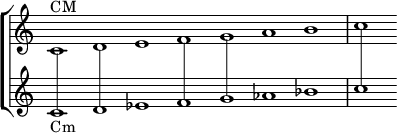Parallel key

In music theory, a major scale and a minor scale that have the same starting note (tonic) are called parallel keys and are said to be in a parallel relationship.[1][2] For example, G major and G minor have the same tonic (G) but have different modes, so G minor is the parallel minor of G major. This relationship is different from that of relative keys, a pair of major and minor scales that share the same notes but start on different tonics (e.g., G major and E minor).
A major scale can be transformed to its parallel minor by lowering the third, sixth, and seventh scale degrees, and a minor scale can be transformed to its parallel major by raising those same scale degrees.
In the early nineteenth century, composers began to experiment with freely borrowing chords from the parallel key.
In
See also
- Harmonic parallelism
- List of major/minor compositions
- Picardy third
- Voice leading
References
- ISBN 978-0-07-294262-0. "A major and a minor scale that have the same tonic note are said to be in parallel relationship."
- ISBN 0-03-020756-8. "When a major and minor scale both begin with the same note ... they are called parallel. Thus we say that the parallel major key of C minor is C major, the parallel minor of C major is C minor."
- ISBN 978-0-300-09239-4.

